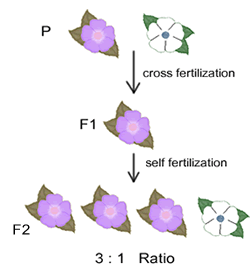 Genetics Review
Genetics Review
1. Describe Mendel’s experiments and know terms relating to the experiment
(P, F1, F2, cross pollination, true-breeding)
Mendel took two plants who differed in one trait (purple vs white flowers), these were called the Parent (P) generation. Using cross-pollination, he bred those plants to create the first filial (F1) generation. In all cases, the F1 generation only displayed one of the traits, he referred to this as the dominant trait.
Mendel then took the F1 generation plants and self-fertilized, by crossing the flowers with flowers on the same plant. The offspring of this cross was called the second filial generation (F2). The F2 generation always had the same ratio: 3/4 displayed the dominant trait, 1/4 displayed the recessive trait.

2. Explain the three principles that Mendel developed.
1. The Principle of Dominance and Recessiveness - one trait is masked or covered up by another trait
2. Principle of Segregation - the two factors (alleles) for a trait separate during gamete formation
3. Principle of Independent Assortment - factors of a trait separate independently of one another during gamete formation; another way to look at this is, whether a flower is purple has nothing to do with the length of the plants stems - each trait is independently inherited
3. Know the relationship between alleles, genes and chromosomes.
Genes are made of two alleles, the alleles are located on chromosomes. Chromomes come in pairs (humans have 23 pairs).
4. Use punnett squares to do genetic crosses. There are different types of crosses. You should know how to do each
-- basic crosses that involve dominance and recessiveness (Bb x bb)
-- crosses that involve codominant or incomplete dominance (red, blue and purple flowers)
-- crosses that involve two traits – dihybrid crosses (AaBb x aabb)
5. Know basic genetic terms
-- genotype/phenotype: genotype is the letter combination used to represent a gene, phenotype is the appearance
-- heteroygous/homozygous: heterozygous is when an organism has two different alleles (Aa), homozygous is when the alleles are the same (aa or AA)
-- dominant/recessive: dominant genes cover up recessive genes when present
-- monohybrid/dihybrid: monohybrid crosses only look at one set of traits (AA x aa) , dihybrids look at two sets of traits (AABB x aabb )
-- polygenic trait - a trait that is controlled by multiple genes, such as hair and skin color (AABbCcDd)
-- heredity: the passing of traits from parents to offspring
-- genetics: the study of heredity
-- allele/gene: an allele refers to a differing form of a gene
-- true-breeding: an organism that has the same alleles, homozygous (AA or aa)
-- probability: the likelihood that something will occur
--segregation: the separating of chromosomes during gamete formation
-- independent assortment: chromosomes randomly sort in during gamete formation, independent of other chromosomes
--fertilization: when a sperm and egg join
-- multiple alleles: traits that are controlled by more than two alleles, blood type
-- gametes: sex cells, sperm and egg
-- hybrids (Tt): organisms that have one of each type of allele
In a certain plant, flowers can be red, white, or pink.
1. Is this an example of codominance or incomplete dominance? Show the letters you would use to represent each color.
Incomplete, neither red nor white is apparent in the hybrids
RR = red | RW = pink | WW = white
2. Show the cross between a red flower and a white flower. List the phenotypic ratios.
All offspring are pink
3. Show the cross between two pink flowers. List the phenotypic ratios.
1/4 red, 1/2 pink, 1/4 white
4. Show a cross between a red and a pink flower? What percentage of the offspring would you expect to be red?
50% red / 50% pink
Practice Problems:
1. In fruit flies, short wings is a recessive trait. Show the cross between a normal fly (WW) and a short-winged fly (ww). List the phenotypic ratios.
WW = normal
Ww = normal
ww = short wings
All offspring are Ww, normal
2. Two heterozygous flies are crossed. Show the cross and list the phenotypic ratios.
3/4 normal, 1/4 short
3. A short-winged fly is crossed with a heterozygous fly. Show the cross and list the phenotypic ratios. 1/2 normal, 1/2 short
4. Also in fruit flies, gray bodies are dominant to black bodies. What phenotypes are expected from this cross: GgWw x ggww
Gray, Normal = 1/4 | Gray, Short = 1/4 | Black, Normal = 1/4 | Black, Short = 1/4
5. If you cross a gray bodied fly (GG) that is also short winged (ww) with one that has a black body and short wings, what percentage of the offspring do you expect to be grey bodied and short winged?
100%


